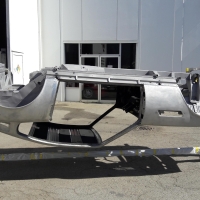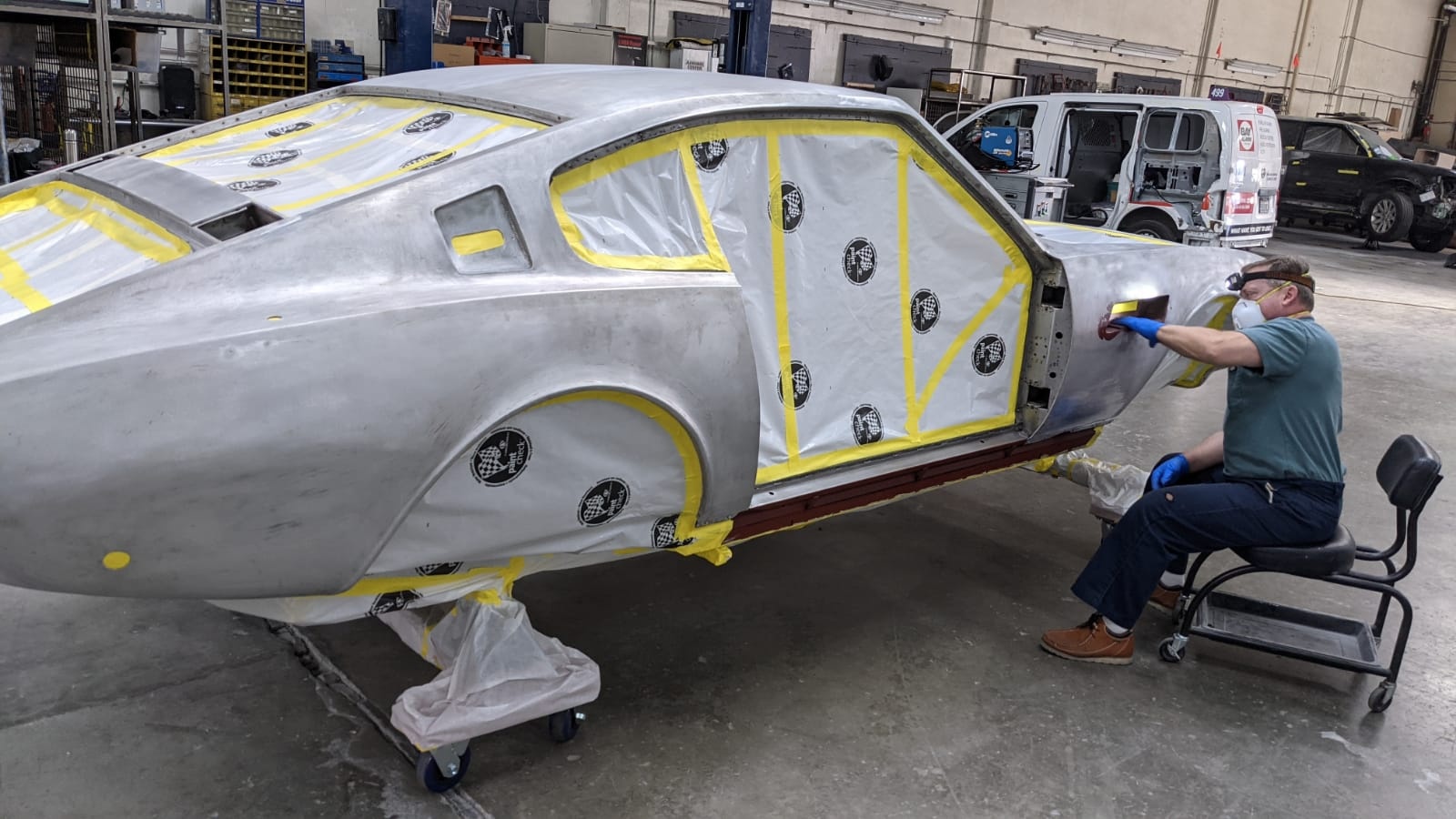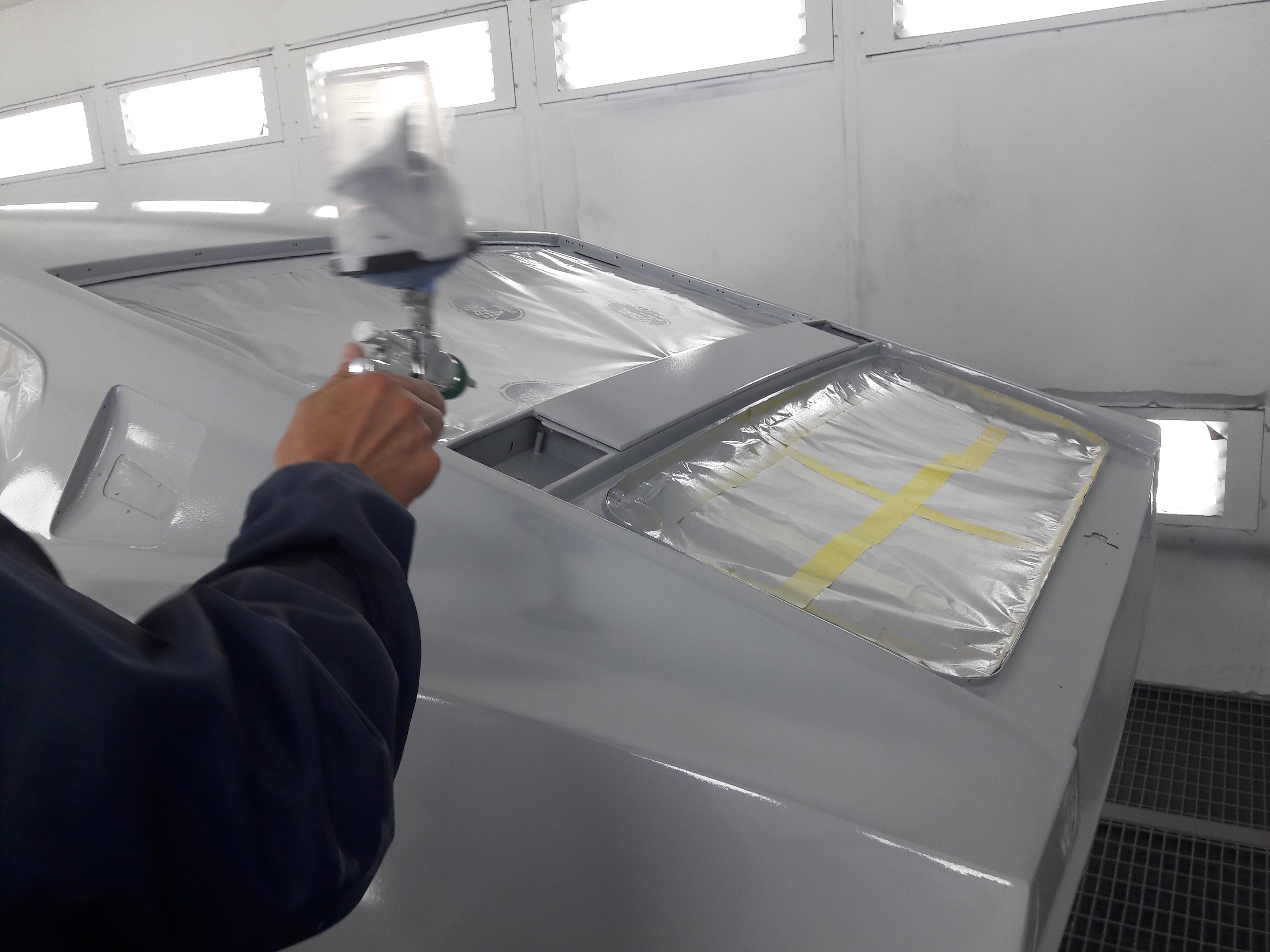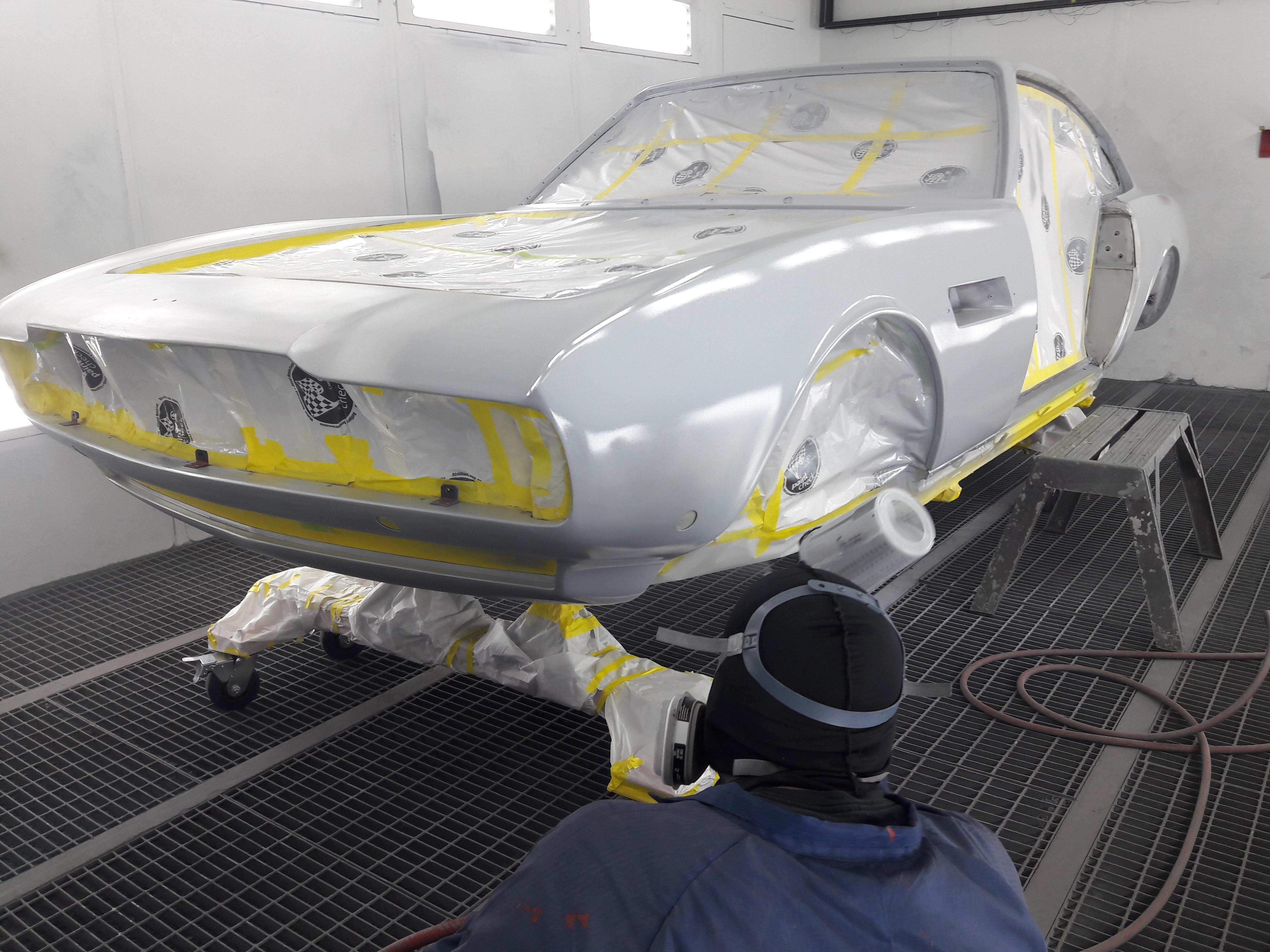Her Majesty's DBS Restoration Update: She is in Primer!
 Gebruder Gumbold
San FranciscoPosts: 549MI6 Agent
Gebruder Gumbold
San FranciscoPosts: 549MI6 Agent
Hello All,
The aluminum body was penned by William Towns, and is most evocative of the period. Every muscle car of the late 1960s has that certain cache, and I say it started with Towns design. Aston Martin kept that basic body style until the early 90s, when new management changed to the Virage platform. Let us enjoy the most classic and cleanest of Town's designs, the Series 1 DBS.
First, the aluminum must be prepped, and sprayed within a few hours, or you get to prep again. The large areas were covered by a D/A,(dual action sander), wielded by the man who is going to paint the car, Alex. I did all of the less fun areas, hand sanding and scuffing the recesses...
Started that day around 7AM, and by 6PM, we wheeled her into the booth...
Gleaming aluminum ready for primer. Very tempted to clearcoat and call it a day, but that would not be true to OHMSS, so she shall be Olive.
That is PPG's DTM (Direct to Metal) epoxy high build primer. 3 components: primer base, reducer, activator, and reducer. Short pot life, so you have to plan your spraying schedule well. It is important that your painter choreograph his movements to reflect the body surfaces. All of this is a warm up for the final topcoats, and Alex will now have muscle memory to achieve the best results.
Note the masking of the undercarriage. No overspray here! many shops do not perform this step for cost cutting.
The primer will form the base for subsequent fillers and topcoats. 2 thick coats, and she rested overnight before being moved to my work area to begin assembling doors, boot lid, bonnet lid, fuel doors, etc. The next process is the block sanding which will ensure a straight body and is the unsung hero of a great paint finish.
Prep is everything!
Getting the gaps right again. We set everything up in bare metal, and now imperfections that are hard to see in metal become apparent with primer on them. The red oxide will be covered in the grey epoxy once any more metalwork is done. The lower right corner of the boot lid needs some attention, so my metal expert is coming for a visit- along with the rear bumper and some trims that he worked on.
Hope that you've enjoyed out journey into the spray booth. It's not apparent to most what goes in to the restoration of a classic car, let alone as Aston Martin, which is a hand made car. The hours going backwards, frustrations, then joys all are wonderful experiences that I would not wish on any of you!
Cheers, Tom










Comments
Gorgeous: I suspect this will be one of the most desirable DBSs around when complete.
Will you be modernising/upgrading it at all?
Thanks for the latest update Tom.
Things really moving on now! More incredible attention to detail and no corner cutting whatsoever! It really will be as good as (or better) than when it left the factory.
Can't wait to see the Olive paint applied. Have you sourced the exact colour? I know Aston Martin's recent DBS OHMSS special edition claimed to be the same colour as the original, but it just looked too light to me..?
Have you looked into the interior finishing yet? Will it be standard or are you going for screen accurate?
Hope the next stages in the bodywork and painting go well and there are no unexpected hiccups.👍️
Dear Emtiem and Red Kind,
Thank you for your kind words, and well wishes on the project.
The last time I "restored" her, I made the mistake of uprating certain parts, and have changed my approach this time to be 1000% as original as possible, to film seen specifications.
That means ditching the 1-2-3 Electronic ignition in favour of the Lucas 25D6 points type ignition, back to standard, original brakes but everything restored to original specification and finishes. If you go on to OHMSSDBS.com, Second Restoration section, you can see a couple of kosher improvements that the concours judges wouldn't see: the Koni front dampers inserted into the original Armstrong front dampers, for instance.
Interior: Finished that last go round in Connolly leather, black of course. Correct shade and texture. I have a black interior DBS just an hour away, and my leather matches perfectly. Spinneybeck NY is the source. Not modern, acid washed leather that is too flat.
The whole approach to the car is as if this were 1969, and I was Bond. The car is officially a "1969 Aston Martin DBS to OHMSS Specification."
Paint: where to start? There is only 1 old ICI code for "Olive." every paint manufacturer will vary from the next, as will every batch. I have been to plenty of concours events, and seen and photographed Olive cars, and each is different. That colour is tough to photograph, as it looks very light in some cases, and darker, depending upon the lighting. Here is a good example of that:
This car has a modern, waterborne basecoat and solvent based clear on top, and it looks it. Not necessarily bad, as 99% of people would say that it is a good paint job, and it is. Question is: Is that paint correct for 1968? Obviously not, they never, ever looked that good from new. "New" was nitrocellulose lacquer, which lasted about 2 years. Heck, the factory would repaint some cars before delivery! Hard to blend, and fades quickly. Needs polish every weekend. Now, VOC regulations make that paint illegal to use, and frankly, the manufacturers don't make it any longer. I have elected, following long dinners with my painter, to use the PPG Euro system of a waterbourne basecoat/solvent clearcoat- referred to as 2K paint. What we can do is to play with the clear to tone down the gloss, and that will give a better, more period correct look. Yes, I will have to wax, but not polish, but she is a trailer queen, so I am prepared for that. The only drawback to the toned down gloss on the clearcoat is that you really can't polish it after painting- which should give a bit of "orange peel," which is correct for the sixties factory paint. I will experiment with test panels.
Another element that bears discussion is the undercoating, or primers beneath the basecoat. That will affect the final colour as well.
I would call the paint on the above car correct, as I would this car painted with Standox Olive. Same ICI code:
I have purchased from a specialist supplier a quart of their Autocolor Olive, and should have some test panels next week. Will keep you updated on any progress. You are correct about this stage being when not to cut corners. With all of the metalwork and panel beating that went on over the last 3 years, I am keeping my foot firmly down on the effort pedal, and, to paraphrase a famous American of the Revolution: "We have not yet begun to spend!"
Cheers, Tom
Your dedication to getting this build right is very inspiring.
Bond’s Beretta
The Handguns of Ian Fleming's James Bond
Thanks for the insight on the paintwork and process Tom.
Fascinating stuff. Commendable that you're going for the look, as it would have left the factory (albeit with a more durable long lasting finish). I must confess, I probably would have succumbed to having it with a 2021 showroom shine, but you're doing the right thing. Authenticity is everything on this project and again, much of this extreme attention to detail is inspiring and would be lost on many.
Look forward to the next update and can't wait to see this car in the metal!🍸️
Wow - this is incredible!
I've just been fortunate enough (much against any expectation I ever had in my life) to buy a 2012 DBS and I am absolutely in awe and in love with it in equal measure.
I can only imagine what it must be like to be rebuilding this car from scratch. Your attention to detail and your patience are most impressive Sir.
Thank you both for the kind comments.
I'm putting my skills to a customer's DB6, which came as a basket case. The customer hired me because he had seen my work, and wanted the same. He is forever butting heads with me over the proper procedure, and wishes to cut corners. I am showing him that there is no easy, nor smooth road to the finish line. There are reversals, detours, bumps, and bruises to get the proper results in a hand made car.
When I hear "Can't you just..." My answer is: "Yes, we can just, and your car will look as though it was restored in a backyard. I am not a backyarder, go elsewhere, please."
A full restoration with aluminum skins coming off the car, done by the factory, to any 60's era David Brown Aston Martin is upwards of GBP 300,000. Labour rate and upholstery materials are now the biggest costs. It wasn't always that way, but times have changed.
That 2012 DBS is a magnificent car! I've only has a ride in a 2009 model, and I will say that it is one of, if not the fastest car that I have ever had the honour to be driven in. The brakes are astonishing! Feels like being in a space capsule to me. No Intruder 1 behind us, though...
Back to bodies: On most every car, the most expensive area in bodywork are the doors. In the early DBS cars, the Sharknose is the most complicated shape, followed by the doors, and then the rear end. A pretty rear end is common amongst the world's most beautiful cars. Just look at an Iso Grifo from behind. Tell me that the rear of that car isn't prettier than the face. Another reason why I love the DBS- both front and rear are beautiful. The most expensive step in the paint process is the block sanding stage and prep for final painting. This is the most overlooked and rushed step, and it will make or break the paint job. Beautiful paint on a body that isn't straight or with bad gaps won't hide the sins. If you're shelling out for paint and materials, spend the extra money and have a straight car.
Had an interesting conversation with a body shop owner last eve. He has been around for about 60 years, apprenticing at the Harrahs Collection as a boy. He was telling me that in the good old days there were 3 major paint manufacturers: Dupont, PPG, and Sherwin (In California). There were no major paint manufactures for auto paint in the UK, and they mainly were using left over military paint in the post war era. The Olive that we see today on Astons was originally a GM colour, and before that, a US Army colour of Olive Drab. The GM colour code was EF8, the EF stood for "Effect," or metallic paint. I will be seeing a 1969 Road Runner in the shop next week, and my shop manager tells me that under the boot carpet is the original Olive paint, identical to the Porsche and Aston Martin Olive of the period. That will be an enlightening find! There must have been 1,000,000 gallons of Olive Drab produced during the Korea and Vietnam eras. Hence, many car makers offered an Olive, even though the name was changed to "Sherwood Green" or similar. It all comes from military Olive Drab, just tarted up with a metallic effect for passenger cars, and with a bit of gloss. I shall be receiving the mixing codes of both the Aston and GM paint from PPG and I will bet they are identical.
Cheers, Tom